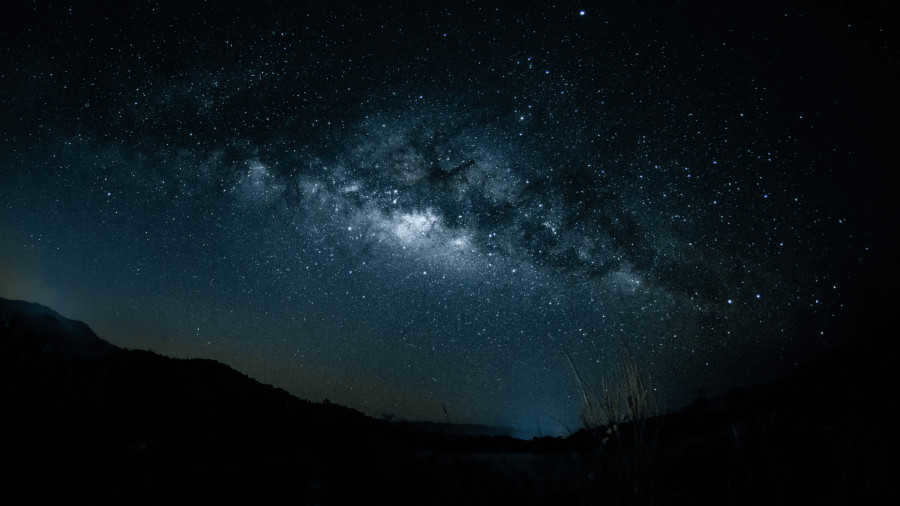Astronomical observations are most favorable in Russia during the month of August. In the northern regions, the period of white nights has come to an end and the weather is still warm enough. Clear nights are more common than cloudy nights throughout the country. This leads to the question: what does the starry sky look like in August 2019? What celestial objects can be seen in the sky during the last month of summer?
- 1 Starry sky and constellations in August
- 1.1 Evening and night sky
- 1.1.1 Arcturus, the Magus and the Northern Crown
- 1.1.2 Summer Triangle
- 1.1.3 Hercules and the Serpentine
- 1.1.4 Jupiter and Saturn in the evening sky
- 1.1.5 Pegasus and Andromeda
- 1.1.6 Perseus and Ascendant
- 1.1.7 Cassiopeia and Polaris
- 3.1 Objects for naked eye observation
- Binoculars and small telescopes receive a rating of 3.2 Stars
- Observation with binoculars and small telescopes is enhanced by Dipscae
- Star clusters are among the objects that can be observed
- Nebulae are also visible
- Galaxies can be seen as well
August offers a chance to admire the beauty of starry skies and constellations
Evening and Night Sky
In temperate regions, the sky darkens late in August, with some places not experiencing dusk until midnight. Therefore, we will refer to this period as the evening sky. What does it appear like?
If you gaze to the northwest, you can spot the Big Dipper (also known as the Plough or the Saptarishi) above the fading remnants of dawn. This iconic constellation is one of the prominent star patterns in the northern hemisphere of the Earth’s sky. The Big Dipper is visible in the Russian sky throughout the year, but its position and orientation vary. In August, it is nearly in its classic position, running parallel to the horizon, making it easily recognizable.
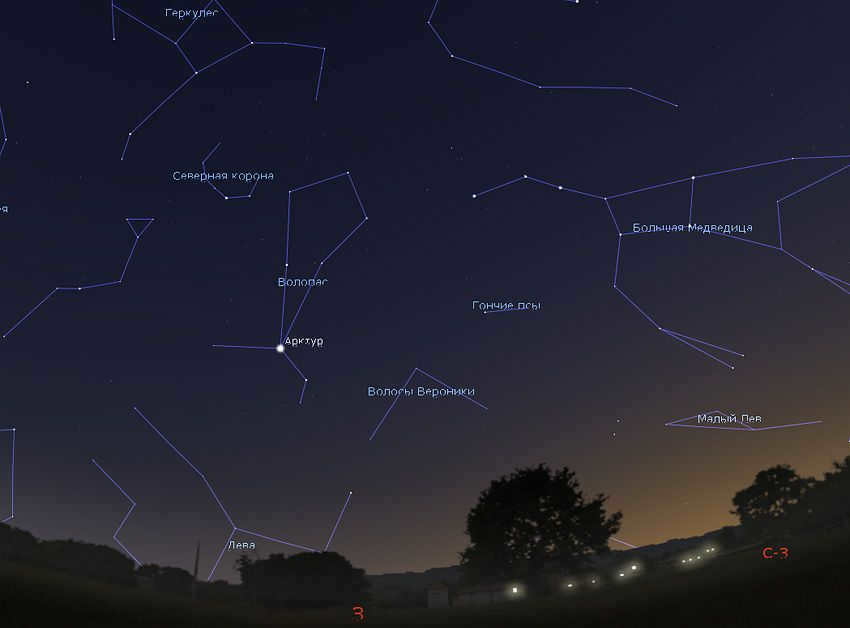
In the month of August, when the sun sets in the west and northwest, you can witness the magnificent evening sky. Using Stellarium, a software that simulates the night sky, you can explore various constellations and stars. One interesting observation is the Big Dipper, a prominent asterism in the constellation Ursa Major. However, upon closer inspection, you will notice that the handle of the Big Dipper appears to be broken. This broken handle leads us to a specific star called Mizar, which is part of the Ursa Major constellation. Additionally, you will notice a faint companion star named Alcor, located next to Mizar. It is quite fascinating to observe these stars, especially if you are able to spot them with the naked eye in a city sky. This indicates that the light pollution in your city is relatively low, making it an ideal location for stargazing enthusiasts.
Arcturus, Capricornus, and the Corona Borealis
Observe a brilliant star in the western sky during the evenings of August. This particular star is known as Arcturus and it is the most luminous star in the northern celestial hemisphere. Arcturus appears whitish-orange in color, but as it descends on the horizon, it can display a dazzling array of rainbow hues.
Arcturus serves as the leading star in the constellation of Bootes, which bears a resemblance to a kite.
Adjacent to Bootes on the left is a small yet incredibly graceful constellation called Corona Borealis, which forms a semicircle of stars with varying brightness in the night sky. At the forefront of the constellation is the star Gemma (also known as Alphecca), positioned at the very center of the crown and resembling a diamond.
Summer Triangle
When gazing southward, well above the horizon, one can behold three luminous stars arranged in the heavens, creating an immense triangular shape with its apex directed downwards. This particular constellation, referred to as the Great Summer Triangle or the Summer-Autumn Triangle, serves as the prominent celestial figure during the month of August.

In August 2019, the night sky was adorned with a beautiful display of stars, particularly when looking towards the south. Of particular note were the two bright planets, Jupiter and Saturn, which could be seen low on the horizon. This image represents the view from Moscow. Image Source: Stellarium
During this time, the summer triangle was visible and easily identifiable. The triangle is formed by three stars from different constellations – Vega, Deneb, and Altair.
Vega is located in the upper right corner of the image and is the brightest star in the constellation Lyra. To easily spot Lyra, one can look for a small parallelogram formation of four dim stars positioned just below Vega.
If you take a closer look at the sides of the cross, you will observe the stars on either side of the “crossbar” that create the magnificent and stunning wings of the Swan. It gives the impression that the bird is soaring towards the horizon.
AltairAltair, the star at the apex of the triangle, leads the Eagle constellation. This constellation bears a resemblance to the Swan, albeit not as pronounced (refer to the image above).
Story of Hercules and the Serpent
By utilizing the celestial formation known as the Summer Triangle, it becomes quite effortless to locate additional constellations that adorn the August night sky. Should you venture your gaze towards the southwestern region, you will find a sprawling expanse that stretches between the triangle and the brilliant star Arcturus. This vast area is home to merely three constellations, namely Hercules, the Serpentine, and the Serpent (which was once a constituent part of the Serpentor constellation).
Within the confines of the Hercules constellation, one can readily identify a distinct pattern composed of four stars of the third magnitude that combine to form an irregular quadrilateral. This particular configuration of stars is often referred to as the “Wedge” or the “Keystone”. By tracing the outline of this asterism, one not only gains access to the remaining stars within the Hercules constellation (which, remarkably, can even be perceived as a human figure!), but also happens upon the breathtaking globular cluster M13. Positioned towards the right edge of the Keystone, this cluster offers a truly captivating sight to behold.
The configuration of Serpentor bears the closest resemblance to a massive, asymmetrical pentagonal crystal positioned beneath the Hercules constellation. Adjacent to this “crystal,” there are chains of relatively faint stars that compose the divided Serpent constellation, disrupted by Serpentor.
Please take note that Jupiter, the largest planet in our solar system, currently resides in the southernmost region of the Serpentine constellation!
Jupiter and Saturn visible in the evening sky
In the evenings of August, you can spot Jupiter as the “bright star in the south” just above the horizon. This planet shines much brighter than any of the actual stars and does not flicker like them. You can observe Jupiter for approximately two hours after sunset before it disappears below the horizon.
About 30° to the east of Jupiter, in the constellation Sagittarius, you will find Saturn. Saturn has a similar brightness to bright stars but, like Jupiter, it shines brightly and steadily without flickering. During August evenings, Saturn can be seen low above the horizon, precisely in the southern direction. To locate the planet easily, draw a vertical line from Vega to the horizon, and Saturn will be positioned on that line!
Pegasus and Andromeda
To the southeast of Saturn, near the horizon, you can observe the zodiacal constellations Capricorn and Aquarius. If you shift your gaze further east, you will notice a prominent square formed by several second magnitude stars. This square is known as The Great Square of Pegasus, which is the central feature of the Pegasus constellation.

The August 2019 night sky, when observed towards the southeast and east, reveals a magnificent display of stars. In particular, there is a notable chain of stars that stretches from the upper left corner of a square to the east. This chain is known as the Andromeda constellation. Positioned above the center of this celestial formation, on a truly clear and dark night, one can catch a glimpse of a faint and ethereal spot. This spot is none other than the Andromeda galaxy – an extraordinary entity that holds the distinction of being the farthest object visible to the naked eye without the aid of optical instruments in regular viewing conditions. Its immense distance from us is a staggering 2.5 million light years.
Perseus and Ascendant
At last, the constellations of Perseus and Ascendant emerge in the direction of the northeast and north. The depiction of Perseus is reminiscent of an upside-down slingshot, with its brightest star, Mirfak, positioned at the focal point. Finding this star is a simple task, as it lies along the extension of the Andromeda star chain and possesses a similar level of brightness to the stars in Pegasus and Andromeda.
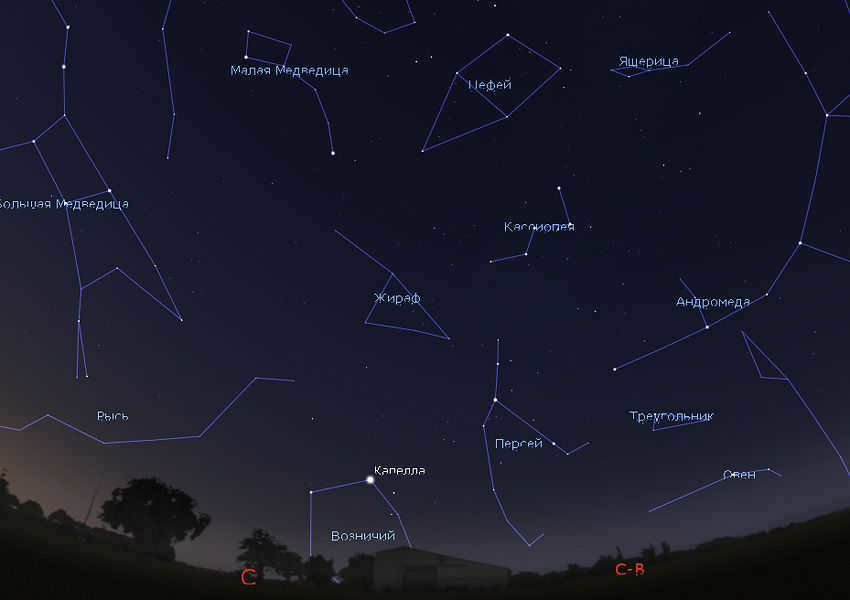
In August 2019, when we look towards the northeast in the evening, we can admire the beautiful starry sky. This captivating view is depicted in the image above, created using Stellarium, a popular software for astronomy enthusiasts.
One of the prominent features of the August sky is the presence of the bright star Capella. This star can be observed in the middle zone of Russia during August evenings, although it may not be visible in regions like Crimea and the Caucasus where it is located below the horizon. Capella can be found in the constellation of Ascendant, and its brilliance makes it a noticeable point of interest for stargazers.
Cassiopeia and Polaris
Located in the northeast is the well-known constellation of Cassiopeia, which can be easily recognized due to its resemblance to the Latin letter W. Positioned above Andromeda and Perseus, Cassiopeia serves as a useful guide to these two constellations.
Polaris, also known as the North Star, can be found almost directly above the northern horizon, with its altitude matching the latitude of your current location. For instance, in St. Petersburg, Polaris is positioned 60° above the horizon. Unlike other stars, Polaris remains stationary in the sky, making it easy to locate.
The simplest way to locate Polaris is by observing the stars in the Big Dipper’s handle.
Morning skies adorned with stars and constellations in August
The appearance of the sky before dawn in the month of August is distinctively different from the evening sky. At this time, all the constellations of spring have descended below the horizon, making way for the constellations of Volopassus, Northern Crown, Serpent, and Snake. The constellation of Hercules has also partially dipped below the horizon. The Summer Triangle can be seen towards the western horizon, occupying the same spot where the star Arcturus was visible during the evening hours.
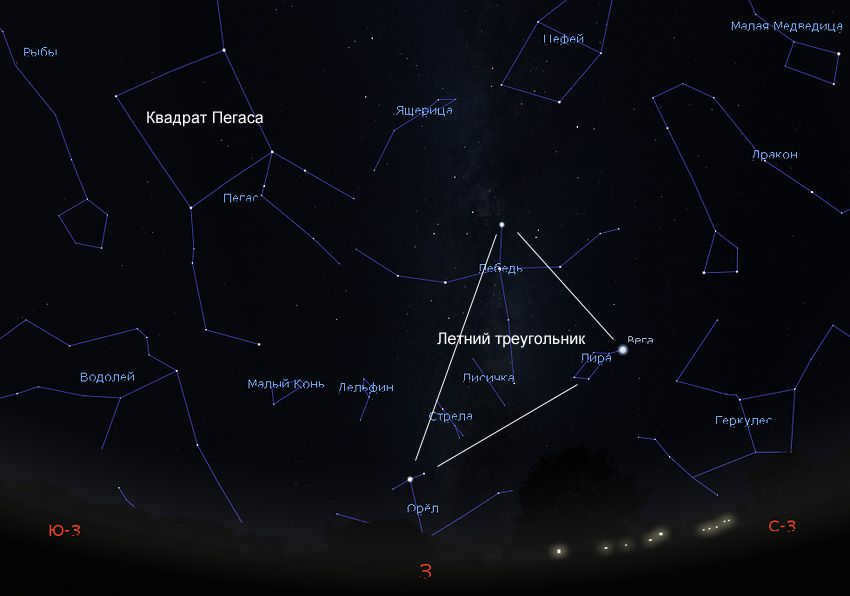
The August morning sky is adorned with stars. When looking towards the west, one can observe a breathtaking view. (Figure: Stellarium)
The southern region of the sky is dominated by the constellations of autumn. Pegasus and Andromeda can be seen at a high position in the sky. Below them, the expansive space is filled with the constellations of Aquarius, Pisces, and Cetus. Unfortunately, these constellations lack bright stars, making them difficult to observe in urban areas.
However, the compact constellations of Aries and Triangle are more noticeable, positioned below the chain of stars in Andromeda.
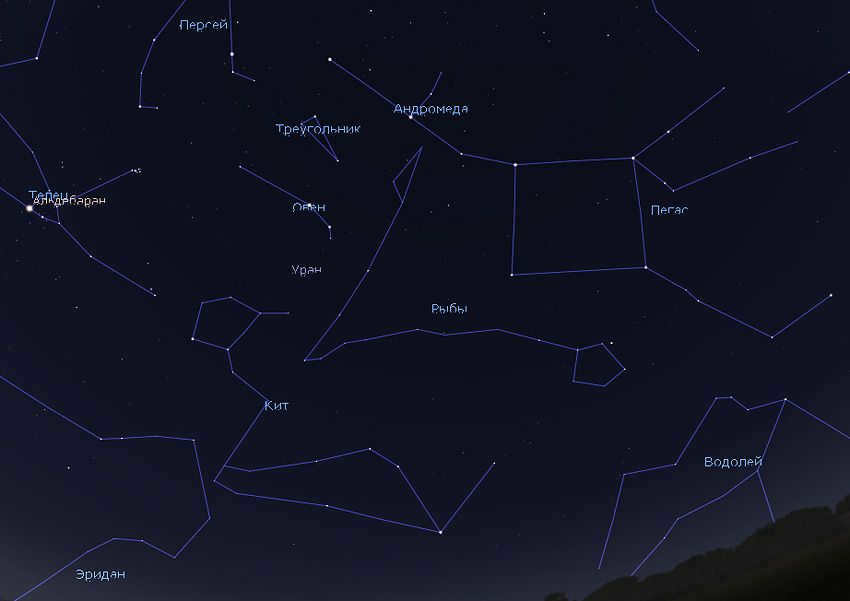
During the month of August, early mornings offer a magnificent view of the starry sky, especially when looking towards the southern direction. This celestial spectacle is beautifully captured in the image above, created with the help of Stellarium software.
As we gaze towards the eastern part of the sky, we can observe a prominent presence of bright winter constellations. Among them, the majestic figure of Orion stands out, accompanied by the constellation of Taurus, which is led by the star Aldebaran. One noteworthy feature of Taurus is the stunning Pleiades star cluster, which, when seen with the naked eye, resembles a small dipper consisting of five brilliant stars.
Continuing our celestial journey, we find the constellation of Ascendant to the left of Taurus, while below it lies the constellation of Gemini. In the August morning sky, the two brightest stars of Gemini, Castor and Pollux, align one above the other, adding to the enchantment of the starry panorama.
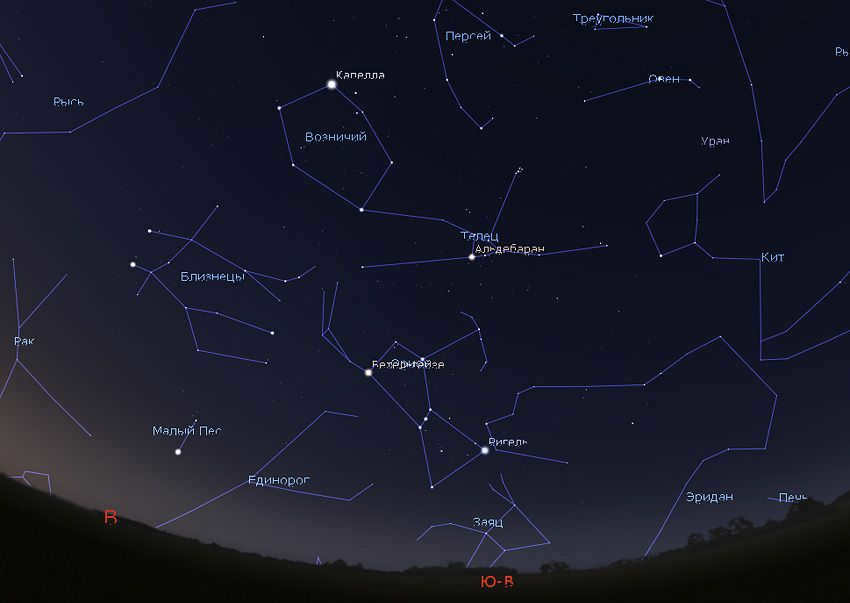
In August, when you gaze at the morning sky in the southeastern direction, you will be greeted by a breathtaking display of stars. This celestial show is truly a sight to behold, and it is made even more remarkable by the presence of the Moon. Throughout the month, the Moon will make its journey across the sky, starting as a thin sickle low on the western horizon and gradually becoming fuller as it moves eastward. On August 9th, 2019, the Moon will meet Jupiter, creating a mesmerizing celestial conjunction. A few days later, on August 11th and 12th, the Moon will be in close proximity to the planet Saturn, adding to the astronomical spectacle.
The latter half of August brings a shift in the Moon’s position, as it transitions from the evening sky to the night sky and ultimately to the morning sky. As it traverses the constellations of Pisces, Aries, Taurus, and Gemini, the Moon becomes increasingly prominent and rises higher in the sky. This progression allows for even more opportunities to appreciate the beauty of the night sky and its celestial wonders.
The Moon will not obstruct the observation of dim objects during the first and last weeks of August, as well as evening observations in the latter half of the month.
Objects to view without the aid of a telescope
Altair is the most luminous star in the constellation of Eagle, with a magnitude of 0.76. It forms part of the Great Summer Triangle along with Vega and Deneb. It is the fourth brightest star in the summer sky.
Antares is a red supergiant star located in the Scorpius constellation, with a magnitude of approximately 1.0 (variable). It can be observed in the evenings, hanging low above the horizon in the south and southwest. In August 2019, the planet Jupiter will be in close proximity to Antares.
Arcturus is a brilliant orange star that can be seen in the western and northwestern skies during the evening and early night. Due to its low position above the horizon, it often twinkles brightly and displays various colors. It has a brightness of -0.04m, making it the brightest star in the sky during August.
Vega is the primary star in the Lyra constellation and the second brightest star in the summer sky, with a luminosity of 0.03m. It is part of the Great Summer Triangle. In August, it can be observed in the evenings and nights near the zenith in the southern sky, and in the mornings it can be seen high above the southwestern horizon.
δ Cepheus is a pulsating variable star located in the Cepheus constellation and serves as the prototype for Cepheid stars. Its brightness varies from 3.5m to 4.4m, with a period of 5.366 days. It can be observed throughout the dark hours of the day.
Deneb is the most brilliant star in the Swan constellation with a luminosity of 1.25 m. It is part of the Great Summer Triangle along with Vega and Altair. Deneb is the brightest star in the Northern Cross asterism and has the highest luminosity, being 196,000 times brighter than the Sun. Its distance from Earth is 2,600 light years.
Capella is the third brightest star in the summer sky with a luminosity of 0.08 m. It is the leading star in the Ascendant constellation. In regions with middle latitudes, Capella can be observed throughout the dark hours of the day in the northeast, while in the southern part of Russia, it rises at night.
Mizar and Alcor are the most renowned double star in the celestial sphere. They are situated on the handle break of the Big Dipper. In reality, it is a system consisting of 6 stars, of which only 3 can be observed using amateur telescopes.
Albireo is known for its stunning beauty as one of the most exquisite double stars in the night sky. This celestial wonder consists of a golden-yellow 3.4 m star and a 5.1 m blue companion, separated by a distance of 34″. It can be found in the constellation of Swan, which is commonly referred to as the Northern Cross due to its shape resembling a cross.
γ Delphinus is a captivating double star situated in the constellation Delphinus. It is composed of a vibrant yellow star with a magnitude of 4.3 and a pristine white star with a magnitude of 5.2. Even with small telescopes, it is relatively easy to distinguish the two components, as they are separated by an angular distance of 10″.
ν of the Dragon is a wide pair of white stars that form an awe-inspiring double star system. When observing the night sky with binoculars, this stellar duo stands out as one of the most beautiful sights. The distance between the two stars is approximately 100 sv years.
β Lyrae is a variable star that undergoes eclipses in the constellation Lyra. It experiences changes in brightness from 3.3 magnitudes to 4.3 magnitudes over a period of 12.94 days. When observed through a telescope, a blue 7.2 magnitude companion star can be seen near β Lyrae.
ε Lyrae is a highly renowned star known as the “double double double”. Even when observed with binoculars, it can be seen as two separate stars. However, when viewed through a telescope with high magnification, each of the two stars splits into a pair of stars. ε Lyrae is located in close proximity to the star Vega and is an excellent celestial object to observe with small instruments.
R Lyrae is a semi-regular variable star that exhibits changes in brightness from 4.0 magnitudes to 5.0 magnitudes over a period of 46 days. It is situated to the northeast of Vega.
61 Swan is an exquisite binary star. It comprises of two orange stars with magnitudes 5.2 and 6.1, separated by an angular distance of 24″. It is one of the nearest stars to the Sun and was among the first stars to have its distance directly measured by Friedrich Bessel in 1838.
Swan χ is a variable star with a long period in the constellation Swan. It is positioned along the line connecting Albireo and Deneb. Its brightness fluctuates from magnitude 3.3 to 14.2 over a period of 407 days. During its peak, it can be seen with the naked eye, but during its minimum, it requires powerful amateur telescopes for observation!
η of Eagle is a prominent Cepheid star. It has a luminosity that varies from magnitude 3.6 to 4.5 over a period of 7.166 days.
The star known as Cepheus’ μ or Garnet star is a red supergiant located in the constellation Cepheus. It is classified as a semi-regular variable, meaning that its brightness changes periodically. With a period of approximately 730 days, its luminosity can range from 3.4 m to 5.1 m. Cepheus’ μ is considered one of the most reddish stars visible in the night sky.
Using dipscopes for observation in binoculars and small telescopes
Clusters of Stars
M3 – A brilliant globular cluster found in the constellation Canis Major. An effortless object to observe using binoculars.
M11 – The star cluster known as the Wild Duck. It is one of the most stunning diffuse star clusters and is situated in the constellation Scutum. It is exceptionally dense and appears globular when viewed through binoculars. It has a distinctive V-shape. The cluster is located at a distance of 5600 light-years.
M13 – One of the most exquisite globular clusters. It can be found in the constellation Hercules, on the right edge of the Clyne asterism. A superb object for observation using binoculars and amateur telescopes.
M15 – A bright globular star cluster located in the constellation Pegasus. It is easily observable using binoculars.
M25 is a stunning star cloud within the Sagittarius constellation, situated near the Teapot asterism, around 6 degrees north of its lid.
M39 is a magnificent open cluster located in the Swan constellation. It can be found near Deneb, amidst the dense Milky Way. This cluster is a perfect target for binocular observation, and under optimal conditions, it may even be visible to the naked eye.
Cr 399, also known as Hanger or Brocchi cluster, is a captivating asterism situated in the Foxy constellation. This object is best observed with binoculars or a small telescope at the lowest magnification. Interestingly, it bears a striking resemblance to a clothes hanger!
M8 is a diffuse nebula known as the Lagoon in the constellation Sagittarius. It is a bright cloud of interstellar hydrogen that is crossed by a dark band of cosmic dust. This nebula is located in the thick of the Milky Way. It is easily visible in southern Russia, although at the latitude of St. Petersburg and Moscow, it appears very low above the horizon.
M20, also known as the Trifid Nebula, is a bright diffuse nebula in the constellation Sagittarius. It is an excellent object for observation for those living in southern Russia.
M27, also called the Dumbbell Nebula, is the brightest planetary nebula. It is located in the constellation Vulpecula. It can be easily seen even with 50 mm binoculars, and with a telescope that has an aperture of 100 mm or larger, you can examine its shape in detail.
M57 or the Ring Nebula. One of the most well-known planetary nebulae in the night sky. Situated in the constellation Lyra to the south of Vega, positioned between the stars γ and β. An excellent celestial object for amateur astronomers to observe! It presents itself as a small smoke ring.
NGC 7009 or also known as the Saturn Nebula. A planetary nebula found in the Aquarius constellation. With a brightness rating of 8.0 m, it resembles the planet Saturn when viewed through a telescope due to its elongated shape.
Galaxies
M31 also known as the Andromeda Nebula is a spiral galaxy that is located near our own Milky Way galaxy. It is the farthest object that can be seen with the naked eye and when viewed through binoculars, it appears as a hazy patch stretching from the northeast to the southwest. The distance between the Andromeda Nebula and our galaxy is approximately 2.5 million light years. Its brightness is measured at 3.4 m.
M33 is a galaxy situated in the Triangle constellation, which is located south of the Andromeda Nebula. On dark and clear nights, it can be observed in the sky without the aid of any optical instruments, appearing as a faint spot. However, when observed through binoculars or a telescope, it is highly sensitive to light pollution, making it extremely challenging to locate in urban areas.
M81 and M82 form an exquisite duo of galaxies located in the Ursa Major constellation. These celestial objects can be easily spotted even with 50-mm binoculars, while telescopes with an aperture exceeding 120 mm allow observers to discern the intricate shapes of these galaxies.
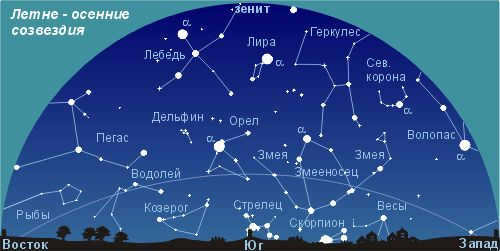
The night sky in July offers a breathtaking view of the stars, with a total of 10 constellations visible simultaneously. This makes it the most star-filled time of the year. While Venus and Jupiter gradually fade from sight, Mercury and Mars can still be seen in the middle latitudes of the Northern Hemisphere. Saturn, on the other hand, remains visible in the sky. Additionally, the constellations of the Serpent, Scorpius, Dragon, and Bird of Paradise are also prominently visible.
Other notable constellations in the summer sky: June, July, August
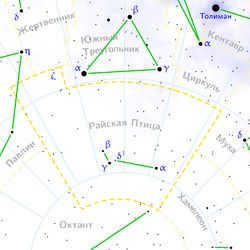
This constellation, located in the southern hemisphere near the pole, is known as Bird of Paradise. It covers a small area of 206 square degrees and is considered one of the least noticeable constellations. To locate Bird of Paradise in the sky, one can use the Southern Triangle as a guide. By following the lines from Alpha and Gamma of the Triangle towards the pole, you can find this constellation. Unfortunately, Bird of Paradise cannot be seen from the territory of Russia.
With the naked eye, it is possible to see only about twenty stars in this constellation, and the largest stars in Bird of Paradise have magnitudes of 4 and 5.
The most prominent star in Bird of Paradise is Alpha, which is an orange giant currently transitioning into a white dwarf.
The second brightest star in this constellation is Gamma, a yellow giant located 160 light years away from Earth.
Completing the group of brilliant celestial bodies is Beta of the Bird of Paradise, a binary star system made up of an orange giant and a white companion.
Also worthy of mention is a star known as Alice, which was named by Kir Bulychev. This renowned science fiction author even possesses a certificate confirming his ownership of the star’s name in the constellation of the Bird of Paradise.
Among the captivating objects in deep space, the globular cluster NGC 6101 stands out, offering a captivating sight through a telescope of moderate power.
Sacrifice
Offering
Sacrifice is an act of offering something valuable or important as a token of devotion or surrender. It is a way of expressing one’s commitment, dedication, or loyalty to a cause, a person, or a belief. Sacrifice can take various forms, such as giving up one’s time, money, comfort, or even one’s life. It requires a willingness to give up something of value in order to gain or achieve something greater. Sacrifice is often seen as a noble and selfless act, demonstrating strength, courage, and selflessness.
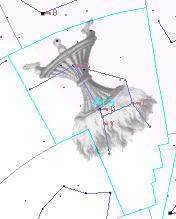
The Sacristy is an ancient constellation mentioned in Ptolemy’s catalog. It is a small constellation located in the southern hemisphere, and can be easily spotted by looking at the neighboring constellations of Peacock and Scorpius. The Sacristy is situated south of the “tail” of Scorpius and west of Alpha Peacock. However, it is not visible from Russia.
In terms of shape, the Sacristy constellation resembles the letter H. When observed with the naked eye, it is possible to see up to 60 stars in the Sacristy.
Among these stars, the brightest one is Beta of the Sacristy. It is an orange giant that shines 4.6 thousand times brighter than the Sun.
The alpha star in the Sacristy is a double star and is located approximately 242 light-years away from Earth.
The constellation contains a multitude of celestial bodies in the vast reaches of space, such as star clusters, globular clusters, and nebulae.
Corona Borealis

The Northern Crown is a constellation located in the northern hemisphere, which has been recognized since ancient times. It ranks 73rd in terms of area and only around 20 stars are visible to the naked eye.
In Russia, the Northern Crown can be observed throughout the country, with the best viewing time being in late June to early July. It is easily identifiable in the night sky, as the constellation resembles a wreath or a semicircular arc formed by 6 stars. Reference points for locating the Northern Crown include the constellations of Volopassus and the head of the Snake.
The alpha star of the Northern Crown is commonly known as Gemma or Agnosia. It is a binary star surrounded by a dust disk, similar to Vega.
The beta star, also known as Nusakan, is a binary star system located 114 light years away from Earth.
There are additional planets orbiting three stars within this constellation. Of particular interest for study is the star R, which is a yellow supergiant and serves as the archetype for an entire group of variable stars.
Within this constellation, there is also a collection of galaxies known as Abel 2065. This cluster is easily identifiable without the aid of telescopes.
The mythical creature known as the dragon
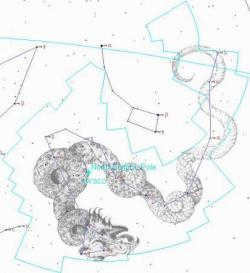
Located near the pole, Dragon is an expansive constellation that covers a whopping 1083 square degrees, making it one of the largest constellations in the northern hemisphere and the 8th largest overall.
Resembling a reptile with its distinctive diamond-shaped head and lengthy tail, this constellation can be seen throughout the year in the northern hemisphere. However, the optimal time for observation is typically from May to December.
Despite the vast expanse and over 80 visible stars, finding this constellation is not an easy task. The most convenient way to locate it is by orienting yourself with the two Bears. The Dragon appears to float between them, with part of its tail running almost parallel to the handle of the Big Dipper. From there, the Dragon seems to encircle the scoop of the Little Dipper and continues southward. By following this winding path, you will eventually arrive at the Dragon’s head – a rhombus shape formed by four bright stars.
Among the many stars in the constellation, there are a few that stand out:
Alpha Dragon, also known as Thuban, is the closest star to Polaris and represents the “tip of the tail” of this celestial beast. During the construction of the Egyptian pyramids, Thuban served as the northernmost landmark for navigators.
Gamma Dragon, also known as Etamin, is the most prominent star in the Dragon constellation. This orange giant is located 148 light years away from Earth and is actually a star system consisting of seven stars with different magnitudes. Astronomers predict that in a million years, Etamin will approach Earth and become the brightest star in the sky, positioned just 28 light years away.
The Dragon constellation is home to several double stars, and in close proximity to Gamma Dragon, the star Kepler-10b hosts a planet that bears striking similarities to Earth. Additionally, the constellation is adorned with various small galaxies and the Cat’s Eye Nebula. Another fascinating phenomenon near the Dragon’s Head is the occurrence of frequent and powerful meteor showers, which can be observed during the autumn months.
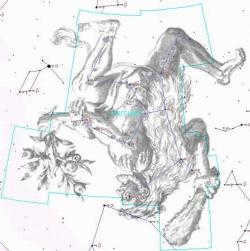
This is one of the largest groups of stars in the northern part of the sky, covering an area of 1225 square degrees (ranked fifth in size). Without the use of telescopes, you can see over 200 stars that form this group of stars.
In its general shape, this group of stars really looks like a person with a square-shaped head and a sword in their hands, running across the sky. It can be challenging to make out the entire figure of Hercules in the sky due to its vast size. One can use the trapezoid-shaped pattern of stars that represents the “torso” of Hercules as a guide. This group of stars can be found between the constellations of the Northern Crown and Virgo.
The best time to observe Hercules is in June. In the northern part of the world, this group of stars can be seen for almost the entire year.
Despite its enormous magnitude, Hercules does not possess a collection of the most luminous celestial bodies. The most luminous one is the Beta star, also known as Corniphoros, which has a magnitude of 2.8. Alpha Hercules is a variable star, meaning its luminosity fluctuates over a span of 90 days.
Among the celestial objects that make up this distant constellation, three globular clusters and a brilliant planetary nebula can be found. The most remarkable object is situated in the vicinity of Hercules’ “belt” – the solar apex.
Naugol
Naugol is a unique and innovative company that specializes in creating high-quality and customizable products. With a team of skilled designers and engineers, Naugol is able to bring ideas to life and deliver exceptional results. Whether you’re looking for a one-of-a-kind piece of furniture or a custom-designed product, Naugol has the expertise and creativity to exceed your expectations. Their attention to detail and commitment to customer satisfaction set them apart from other companies in the industry. Trust Naugol to transform your vision into reality.
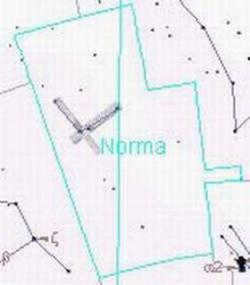
The Naugolnik constellation is one of the smaller constellations in the southern hemisphere. It can be found in the sky by looking at its neighboring constellations. Naugolnik appears as an elongated line, equidistant between the Wolf and Sacristan constellations.
Discovered in 1754 by astronomer Lacaille, Naugolnik is a relatively new constellation. Despite its small size, it contains more than 40 stars that can be seen with the naked eye. During the summer, a portion of Naugolnik can be observed in southern Russia.
Interestingly, the stars within the Naugolnik constellation do not have individual names. The brightest star is Gamma Naugolnik, which is a double star consisting of a supergiant and a bright companion.
Among the entities located in far-off regions of the cosmos, the most remarkable one is an astronomical phenomenon called Ant, which takes the form of a planetary nebula. True to its name, this nebula bears a striking resemblance to the tiny insect.
The Serpentine
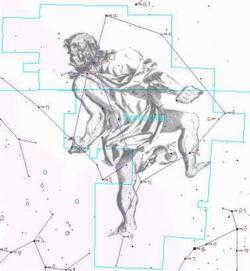
The Serpent constellation is one of the largest equatorial constellations, ranking 11th in terms of area among the 88 known constellations. It covers an impressive 948 square degrees of the night sky.
The shape of this constellation resembles a rocket, with its apex pointing towards the Hercules constellation. It is divided into two parts: the Head and the Tail, with the Snake constellation located to the south. In Russia, the best time to observe the Serpent constellation is in June. It can be seen throughout the country, except for the northern regions.
The primary star in the constellation Serpens is known as Alpha Serpens or Ras Alhage. This star system consists of two giant stars. Alpha Serpens is located in the “head” of the Serpent, and along with Vega and Altair, it forms an equilateral triangle.
Another notable star in the constellation Serpens is 70 Serpens, which is relatively close to Earth at a distance of only 16.5 light-years. This star is also a double star system, composed of two orange dwarfs.
Among the most famous stars in Serpens is SN 1604, also known as Kepler’s Supernova. This star did not explode until the autumn of 1604.
Serpens is also known for its high number of variable stars, with over 2,500 such stars observed in the constellation.
In addition to stars, the constellation Serpens contains several objects of interest in deep space, including several globular clusters, an infrared galaxy, and a diffuse nebula.
Scorpio
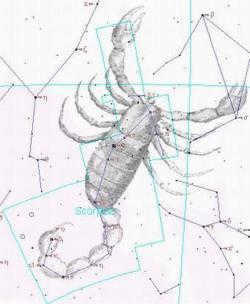
This star pattern can be easily spotted in the night sky and is located within the Milky Way. It has a distinctive shape, resembling a twisting snake. The tail of the constellation borders the Southern Crown, while its “head” extends outwards with three tentacles towards the Serpentine.
Scorpio is one of the largest constellations, covering an area of 497 square degrees. It is also known for being the brightest constellation, with 13 of the brightest stars included within its boundaries.
The most prominent star in Scorpio is Alpha Scorpio, also known as Antares. This red supergiant is 700 times larger than the Sun and shines 9,000 times brighter. Antares is a double star, and upon closer observation, a less noticeable bluish companion can be seen next to the vibrant red giant.
Within the constellation, numerous star clusters are dispersed, with one of them on the verge of transforming into a black hole.
Serpent
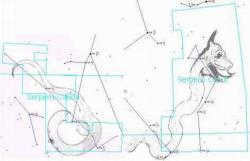
The Snake constellation is categorized as an equatorial constellation. It occupies an area of 637 square degrees in space and on a clear night, it is possible to observe up to 106 stars with the naked eye.
Unlike other constellations, the Snake constellation is unique in that it is not a connected formation. Instead, it is divided into two parts: the Head of the Serpent and the Tail of the Serpent. To guide yourself, you can locate the Northern Crown initially. To the west of it, you will notice a prominent triangle which represents the Head of the Serpent. The rest of the constellation extends further west.
The Snake constellation can be observed throughout various regions in Russia. The optimal time to observe it is in June.
There are no stars of the first magnitude in the composition of the Snake. The Snake’s Alpha is a triple star located at the base of the triangle, which is commonly referred to as the Head. It is considered to be the brightest.
The second brightest star is known as Eta Serpens, which is often referred to as Tang. It is a double star system consisting of an orange giant and a fainter companion.
Another notable star is Delta of the Serpent. It is a double star that also includes two double stars.
Among the deep space objects, we can distinguish the Eagle Nebula. Its star clusters are surrounded by clouds of gas, known as the Pillars of Creation.
The Triangle of the South
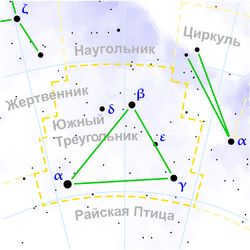
If you gaze up at the midnight sky in July, you will notice three luminous stars forming the Southern Triangle, situated just above the southern horizon. Although it is one of the smallest constellations in the southern hemisphere, covering only 110 square degrees, it is also one of the most radiant.
To locate the Southern Triangle, direct your attention towards the Bird of Paradise constellation, which can be found to the south and closer to the pole. The Circulus line stretches out towards the east, while the Sacristy extends towards the west. With the naked eye, you can distinguish more than 30 stars within this constellation. However, it cannot be observed from the territory of Russia.
Out of the three brightest stars within the Southern Triangle, only Alpha possesses its own unique name – Atrius. This colossal star is a staggering 130 times more massive than the Sun.
This constellation encompasses a star cluster and a merging galaxy.
The Southern Triangle holds significance for its crucial role in navigation. Additionally, its depiction is incorporated into the design of the Brazilian flag.
Exploring the history of the Kaltasinskaya SOSH №1 4G class during the 2020-2021 academic year, which commenced in 2017.
Engaging with the “From the Earth to the Sky” Atlas-determinator, a program aimed at teaching the identification of stars and constellations.
Atlas-determiner “From the Earth to the Sky”. Mastering the art of star and constellation identification.
Pleshakov had a brilliant concept – to develop a children’s atlas that simplifies the process of identifying stars and constellations. Our educators embraced this notion and crafted their very own definitive atlas, which boasts even greater levels of information and clarity.
What do constellations represent?
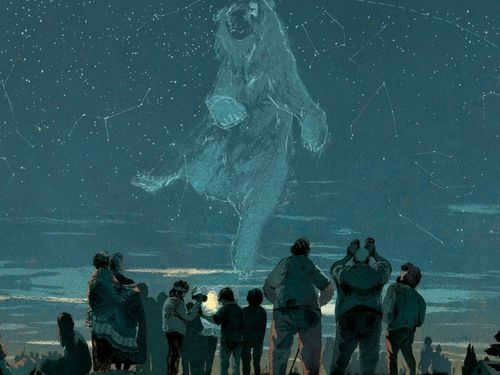
If you cast your gaze upwards, you will be greeted by a myriad of gleaming luminaries of varying dimensions that adorn the celestial expanse akin to a sprinkling of precious gemstones. These celestial bodies are commonly known as stars. Certain stars seem to congregate in clusters and upon closer inspection, can be discerned as distinct groupings. These groupings are referred to as “constellations”. Some of these constellations may bear resemblance to a vessel or the intricate contours of animals, although they are largely products of the human imagination.
Throughout the ages, astronomers have endeavored to study these groupings of stars, imbuing them with a sense of mystique. People sought to categorize and identify common patterns, thus giving rise to constellations. Over time, constellations were meticulously examined, with some being broken down into smaller formations or even ceasing to exist altogether, while others were simply refined and adjusted. For instance, the constellation Argo was subdivided into the smaller constellations of Compass, Kiel, Sail, and Corma.
The history behind the names of constellations is equally fascinating. In order to aid memorization, they were bestowed with names that shared a common element or were inspired by literary works. For instance, it was observed that during a period of heavy rainfall, the Sun would rise from certain constellations, which were subsequently named Capricorn, Whale, Aquarius, and the constellation of Pisces.
With the aim of categorizing all constellations, a decision was made during the 1930 meeting of the International Astronomical Union to officially register 88 constellations. Based on this resolution, constellations are not simply clusters of stars, but rather divisions of the celestial sphere.
What do constellations represent?

Constellations vary in the quantity and brightness of the stars that compose them. There are 30 distinguished groups of stars that are particularly prominent. The Big Dipper is known as the largest constellation in terms of its area. It is composed of 7 bright stars and 118 stars that can be seen without the aid of a telescope.
The Southern Cross, which is located in the southern hemisphere, is the smallest constellation. It cannot be seen with the naked eye and consists of 5 bright stars and 25 stars that are less visible.
The Lesser Horse is the smallest constellation in the northern hemisphere. It contains 10 faint stars that are visible to the naked eye.
The constellation of Orion is considered the most stunning and brightest. It includes 120 stars that can be seen without a telescope, with 7 of them being very bright.
All constellations are categorized as either being in the northern or southern hemisphere. Individuals residing in the southern hemisphere are unable to view the star clusters situated in the northern hemisphere, and vice versa. Out of the 88 constellations, 48 can be found in the southern hemisphere, while 31 are located in the northern hemisphere. The remaining 9 constellations are visible in both hemispheres. The northern hemisphere can be easily recognized by Polaris, a star that consistently emits a strong, luminous glow in the sky. It can be identified as the outermost star on the handle of the Big Dipper.
Because of the Earth’s orbit around the Sun, it is not possible to observe certain constellations, leading to the change of seasons and the shifting position of celestial bodies in the sky. During winter, our planet is located on the opposite side of its solar orbit compared to summer. Consequently, only specific constellations are visible during each season. For instance, the summer sky showcases the triangular arrangement of Altair, Vega, and Deneb stars. In winter, stargazers have the opportunity to marvel at the breathtaking constellation Orion. Hence, the terms “fall constellations,” “winter constellations,” “summer constellations,” and “spring constellations” are sometimes used.
The best time to observe the constellations is during the summertime, and it is recommended to do so outdoors, away from the lights of the city. While some stars are visible to the naked eye, others may require the use of a telescope. The constellations that are particularly prominent and worth observing are the Great and Little Bear, as well as Cassiopeia. During the autumn and winter months, the constellations of Taurus and Orion offer excellent viewing opportunities.
There are several stunning constellations that can be seen in Russia in the northern hemisphere, including Orion, Ursa Major, Taurus, Canis Major, and Canis Minor.
By observing their arrangement and allowing your imagination to run wild, you may be able to envision a captivating hunting scene that has been represented in the sky for over two millennia, much like an ancient fresco. The courageous hunter Orion is always depicted with animals surrounding him. To his right, Taurus is depicted in motion, with the hunter swinging a club towards him. At Orion’s feet, you will find the loyal Canis Major and Canis Minor.
The Orion constellation
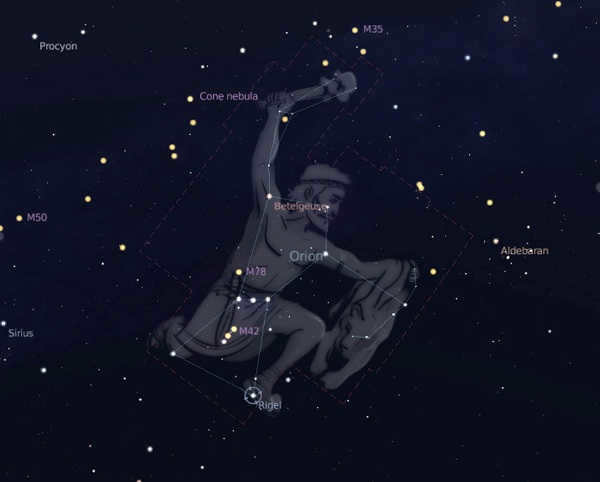
Orion is the largest and most vibrant constellation that can be easily seen during the autumn and winter months. It is visible across Russia. The arrangement of its stars forms the shape of a human being.
The origin of this constellation can be traced back to ancient Greek myths. According to these myths, Orion was a brave and powerful hunter, the son of Poseidon and the nymph Emvriala. He frequently hunted alongside Artemis, but one day, he was fatally struck by Artemis’ arrow during a hunt. Following his death, he was transformed into a constellation.
The Star Betelgeuse
Betelgeuse is situated on the right shoulder of the constellation Orion. It has a diameter 450 times larger than the Sun, and if it were placed in the Sun’s position, it would take up the space of the four inner planets, including Mars. Betelgeuse shines with a brightness 14,000 times that of the Sun.
The Taurus Constellation
Taurus is another vast and incredibly stunning constellation found in the northern hemisphere. It is located to the northwest of Orion and is positioned between the constellations Aries and Gemini. Nearby Taurus, you can also find constellations like Ascendant, Whale, Perseus, and Eridanus.
In middle latitudes, Taurus can be observed for most of the year, except for the latter half of spring and early summer.
The constellation’s history can be traced back to ancient legends, which recount the tale of Zeus transforming into a calf to abduct the goddess Europa and transport her to the island of Crete. The first recorded mention of this constellation was made by Eudoxus, a mathematician who lived in a time preceding our own era.
Aldebaran, not only the brightest star within this constellation but also among the other 12 stellar groups, is situated on the head of Taurus and was once referred to as “the eye”. It surpasses the Sun in size by 38 times and in brightness by 150 times. Aldebaran is positioned 62 light years away from our planet.
The second most luminous star within the constellation is Nat or El-Nat, also known as the bull’s horns. It can be found near the Ascendant. Nat is 700 times brighter than the Sun and 4.5 times larger in size.
The Hyades have an age of 650 million years. They can be easily located in the night sky thanks to Aldebaran, which is clearly visible among them. The cluster consists of approximately 200 stars.
The Pleiades acquired their name due to their nine components. Seven of them are named after the seven sisters from ancient Greek mythology (the Pleiades), while the remaining two are named after their parents. The Pleiades are highly visible during winter. The cluster is composed of around 1000 stellar bodies.
Another equally fascinating formation within the Taurus constellation is the Crab Nebula. It was formed as a result of a supernova explosion in 1054 and was first discovered in 1731. The nebula is located 6,500 light years away from Earth and has a diameter of approximately 11 sv. years.
The constellation Canis Major
This celestial grouping is a member of the Orion constellation family and is surrounded by the constellations Orion, Monoceros, Canis Minor, and Lepus.
Legend has it that Canis Major was once known as Lelaps. Lelaps was an exceptionally swift canine with the ability to outpace any quarry. On one occasion, he pursued a fox that matched him in swiftness. The result of their race was inevitable, and Zeus transformed both creatures into solid stone, positioning the dog among the stars.
The Big Dog constellation is highly visible during the winter months. Sirius, the brightest star not only in this constellation but in all others, has a distinctive bluish glow and is relatively close to Earth, at a distance of 8.6 light years. It is only surpassed in brightness by Jupiter, Venus, and the Moon in our solar system. The light emitted by Sirius takes 9 years to reach Earth and is 24 times stronger than the light from the sun. Interestingly, this star has a companion known as Puppy.
Sirius is closely associated with the concept of “Vacation”. This is because the star Sirius appeared in the sky during the hot summer months. As Sirius is translated from Greek as “kanis”, the Greeks began to refer to this period as vacation.
The Lesser Dog is surrounded by neighboring constellations such as the Unicorn, Hydra, Cancer, and Gemini. This constellation represents the animal that accompanies the hunter Orion alongside the Big Dog.
The origin story of this constellation is quite fascinating, according to mythology. It is said that the Small Dog is Mera, the loyal companion of Icarius. Icarius was taught the art of winemaking by Dionysus and his wine was incredibly strong. One day, his guests mistakenly believed that Icarius was trying to poison them and they killed him. Mera, filled with grief for his master, soon passed away. Zeus then immortalized Mera in the form of a constellation in the night sky.
The two brightest stars in this constellation are Portion and Gomeisa. Portion is located 11.4 light-years away from Earth. It shines slightly brighter and hotter than the Sun, but is otherwise similar to our own star.
The star formation Big Dipper
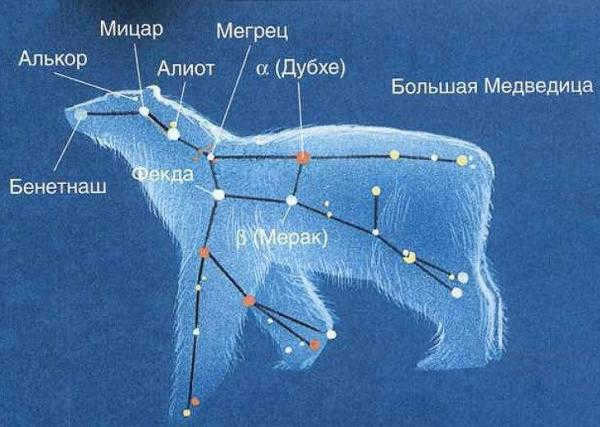
The constellation known as the Big Dipper, which resembles a dipper, is one of the largest constellations among the three. It has been mentioned in the writings of Homer as well as in the Bible. This particular constellation has been extensively studied and holds great significance in various religions.
According to Greek mythology, the Big Dipper is connected to Callisto, a stunning nymph who was involved with Zeus. As a punishment, Zeus’ wife Hera transformed Callisto into a bear. One day, this bear encountered Hera and her son Arcas in the forest. To prevent a tragic event, Zeus transformed both the son and the nymph into constellations.
Dubhe, a red giant, serves as a pointer to Polaris. It is located 120 light years away from Earth.
Alcaide, which is the third most luminous star in the constellation, marks the termination of the tail of the Big Dipper. It is situated 100 light-years from our planet.
Aliot, on the other hand, is the most brilliant star in the constellation, symbolizing the tail. Due to its impressive luminosity, it serves as a navigational aid. Aliot outshines the Sun by a factor of 108.
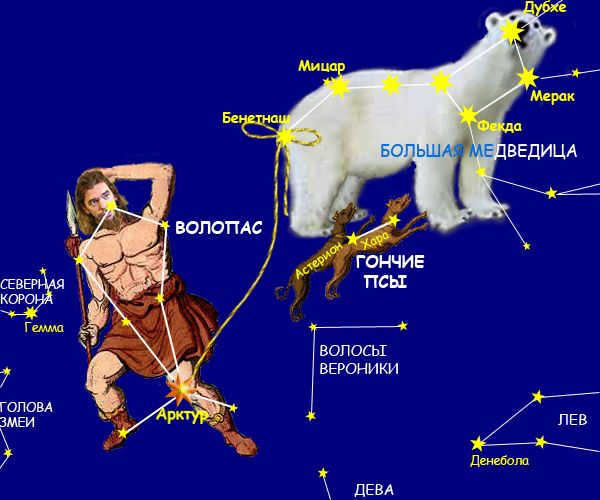
These constellations are the most brilliant and exquisite in the northern hemisphere. They can be observed perfectly with the naked eye on a crisp autumn or frosty winter night. The myths surrounding their creation allow one’s imagination to roam freely, envisioning the mighty hunter Orion, accompanied by his loyal hounds, chasing after his prey, while Taurus and the Plough keep a close eye on him.
Russia is situated in the northern hemisphere, and in this portion of the celestial sphere, only a selection of the numerous constellations that populate the night sky can be observed. Depending on the time of year, their positions in the sky vary.
Altapress.ru has discovered the constellations that can be seen in the Altai region’s sky: not only Orion and Ursa Major, but also Gemini, Vulpecula, and many more.
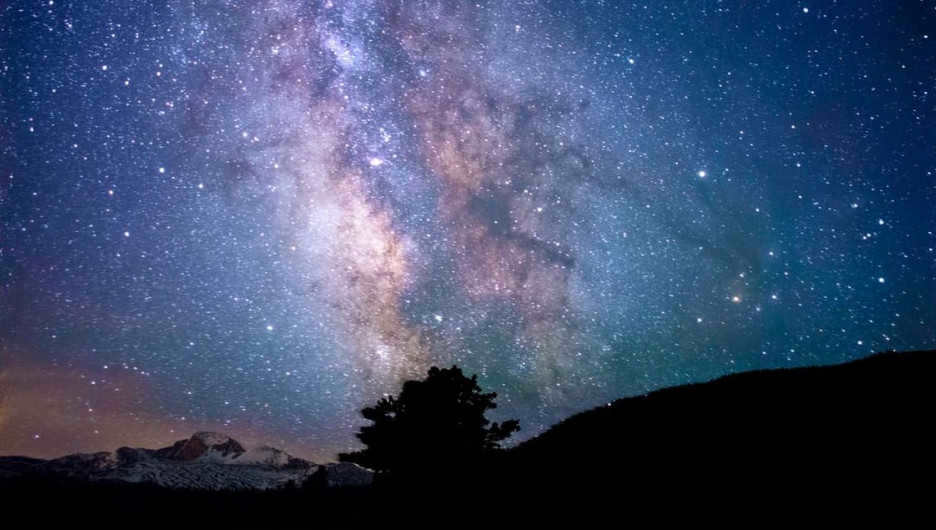
The Orion constellation
The Orion constellation is one of the most easily recognizable constellations in the night sky. It consists of three bright stars that form a row, and just above them is the famous “giant’s armpit” known as the red supergiant Betelgeuse. In Barnaul, this constellation will be visible until mid-April, after which it will gradually disappear below the horizon.
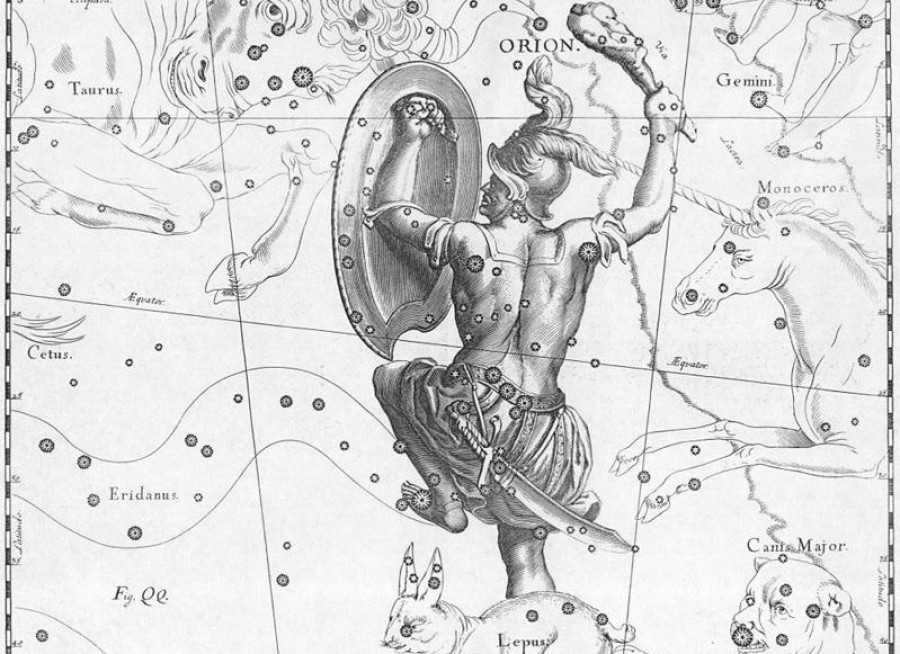
The Great Bear
Another constellation that can be easily seen in the city. It is one of the three largest constellations in the sky. The Great Bear can be identified by its “dipper” shape, which is formed by a group of bright stars. –>
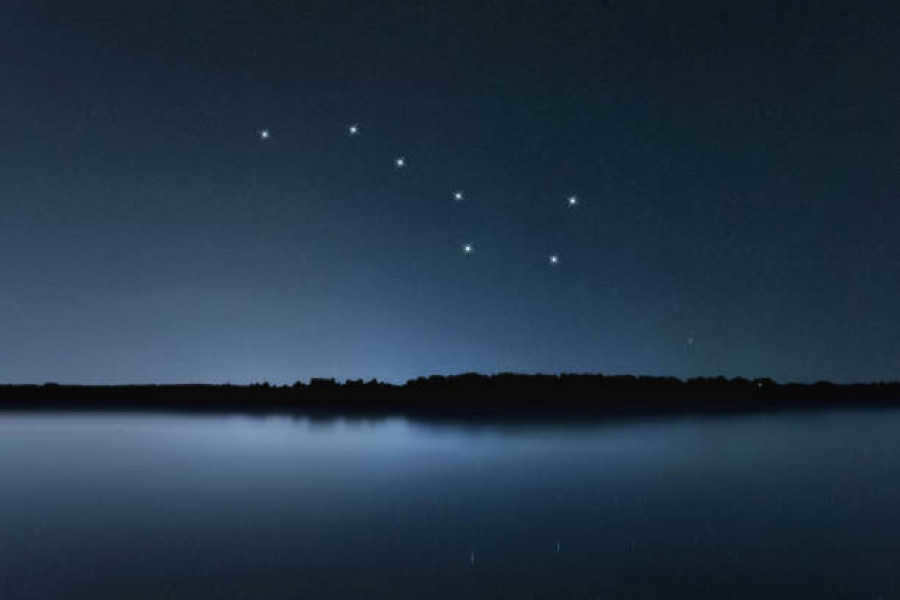
Vladislav Tokarev,
organizer of observations of the astronomical community “Observational Barnaul”:
In the evening, towards the end of March, the constellation of Aries in the western part of the horizon offers a clear view of Mercury. Following mid-April, the planet will be obscured by its presence. Even before that time, the skies above Barnaul reveal the presence of Mars in the constellation Gemini and Venus in Taurus. Additionally, after mid-April, the constellation Orion will no longer be observable in the city sky. Simultaneously, the constellations of Taurus and Big Dog will descend below the horizon. In the latter half of April, a meteor shower known as the April Lyrids (from the constellation Lyra) will occur. The peak of meteorite particle activity is set to take place on April 23.
To locate it, one can direct their attention to the Big Dipper: imagine a straight line connecting the two farthest stars, which will intersect with Polaris at the “tail” of the Little Bear.

Twins
The twins constellation, like Orion, is most visible in the southwestern region of the sky until mid-April.
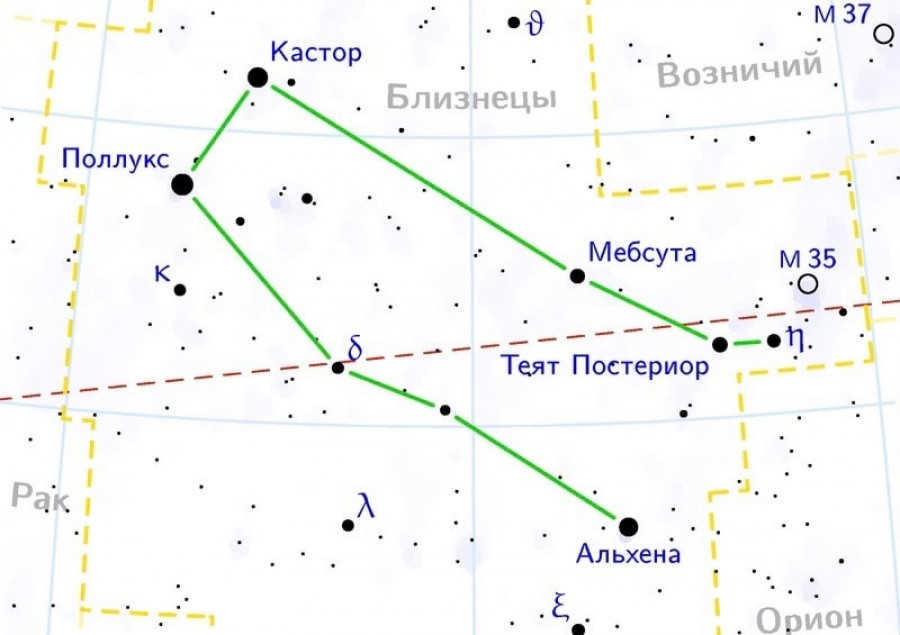
Taurus
Yet another celestial creature in the heavens is Taurus. This constellation is made up of three primary stars: Aldebaran, Elnath, and Alcyone. When observed in the night sky, Taurus appears as a distinctive V shape.
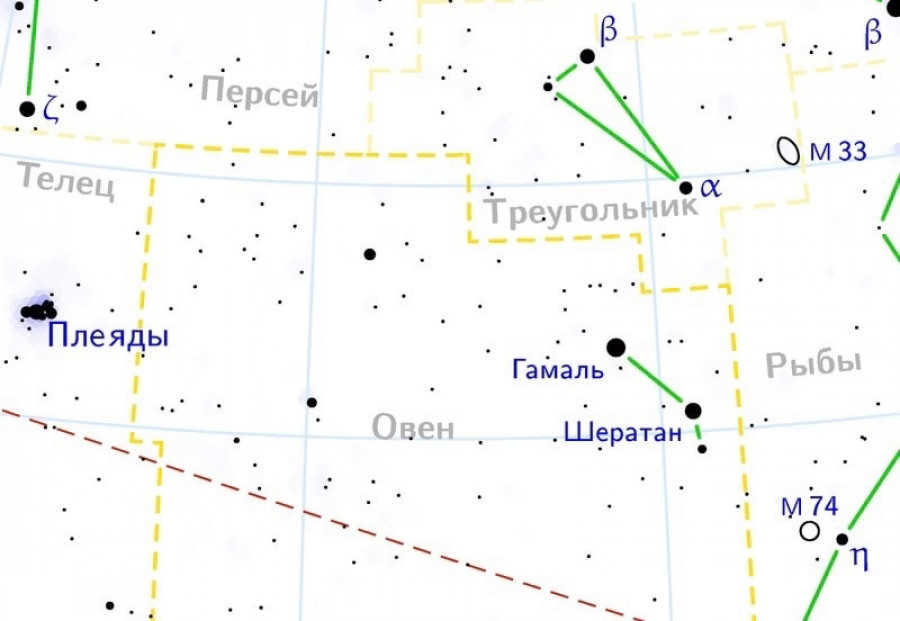
Virgo
The constellation of Virgo will be visible in the night sky until the end of March, with the prominent star Spica located on the southern side of the horizon. While some may mistake this constellation for Aries or confuse the current season, the Barnaul Planetarium confirms that Virgo will continue to shine brightly.
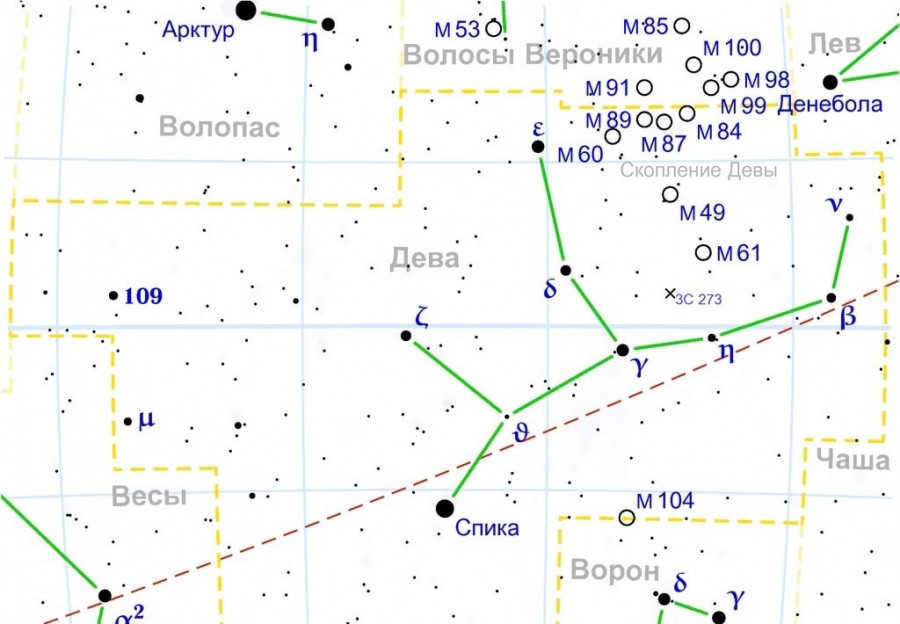
Volopassus
The observer’s attention will also be drawn to the “Star Parachute” with the most brilliant star, Arcturus, located high above the horizon in the southwestern sky until the conclusion of March.
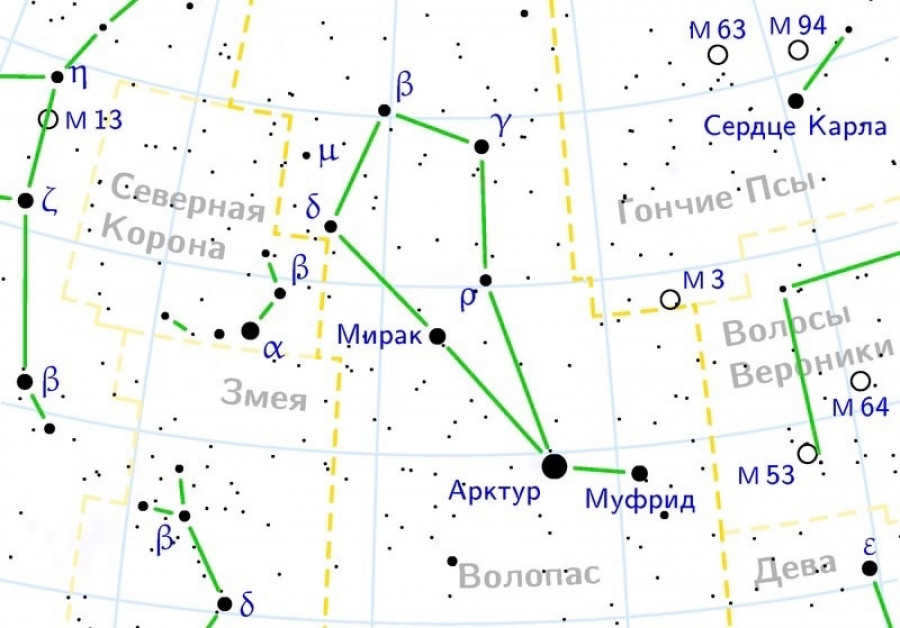
- In order to navigate the sky, it is essential to have a basic understanding of the cardinal directions. A compass or the rising and setting of the Sun in the East and West, respectively, can serve as additional points of reference.
- The presence of city lights often obstructs the view of the starry sky, but if you observe it from a dimly lit street, you will be able to discern the fainter stars.
Which other constellations can we see in the sky?
The expert explains that we will be able to see other constellations in the sky, especially before midnight. However, it is important to note that not all of them will be visible in the city.
